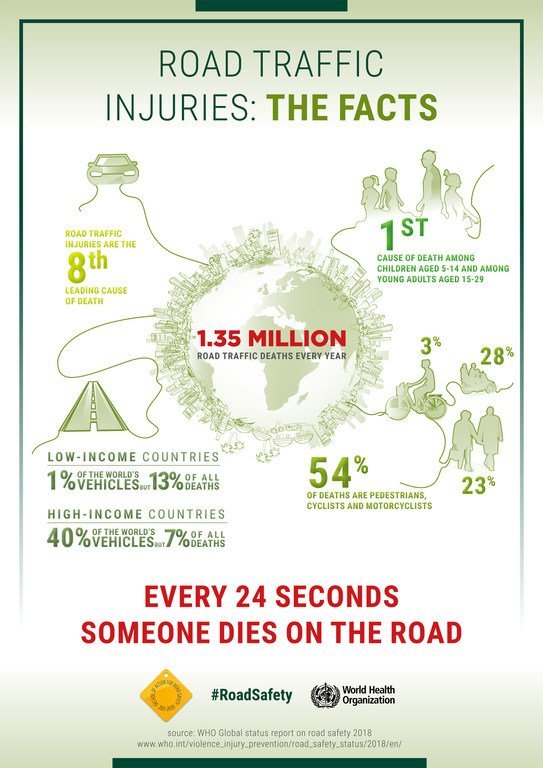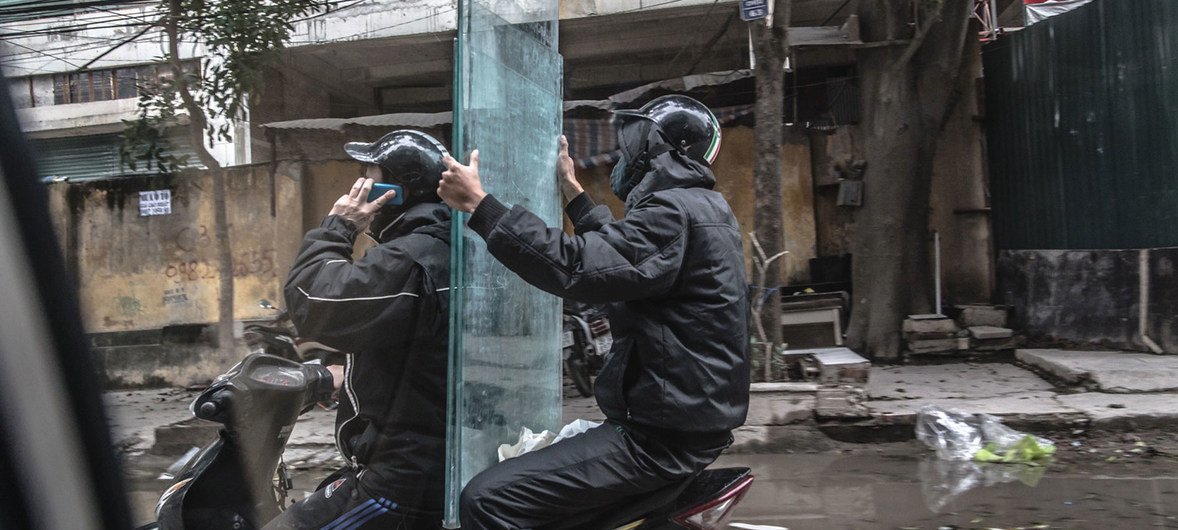© Eric Ganz
Two men transport glass panels via motor scooter in Vietnam. (file)
Saving lives by improving road safety is “one of the many objectives of the 2030 Agenda for Sustainable Development”, the United Nations chief said in his message for the global day set aside for remembering the victims of traffick accidents.
Noting that more than 1.3 million people die in road accidents every year, Secretary-General António Guterres pointed out that more young people between the ages of 15 and 29 die from road crashes annually than from HIV/AIDS, malaria, tuberculosis or homicide.

World Health Organization (WHO)
Facts on road traffic injuries
“The World Day of Remembrance of Road Traffic Victims is an opportunity to reflect on how we can save millions of lives,” he said.
And since 2015, his Special Envoy on Road Safety, Jean Todt, has worked to mobilize political commitment, raise awareness about UN road safety conventions, foster dialogue on good practices and advocate for funding and partnerships.
“While the scale of the challenge is enormous, collective efforts can do much to prevent these tragedies”, the UN chief attested.
In 2018, a UN Road Safety Fund was launched to finance actions in low- and middle-income countries, where around 90 per cent of traffic casualties occur.
And next February, a global ministerial conference on road safety will be held in Sweden to strengthen partnerships to accelerate action.
“Urgent action remains imperative”, concluded the Secretary-General. “On this World Day, I call on all to join forces to address the global road safety crisis.”
‘Ubiquitous yet invisible’
The UN Department of Safety and Security (DSS) calls road traffic crashes a ‘hidden epidemic’.
According to DSS, they have a “dramatically transformative impact” on people’s lives with most causalities remaining “almost invisible to society at large”.
Last February, with the participation of UN leaders from the Secretariat, UN Development Programme (UNDP), UN Population Fund (UNFPA) and others, including the Chef de Cabinet and Special Envoy on Road Safety, the UN launched the Road Safety Strategy in New York and Geneva that showed unity and the shared message of road safety across the UN-system.
The Day has become an important tool in efforts around the world to reduce road casualties.
It offers an opportunity to draw attention to the scale of emotional and economic devastation road crashes cause and recognizes the suffering of victims and the work of rescue services.
Ending fatal road crashes are in line with the 2030 Agenda, particularly in line with Sustainable Development Goal 3 (SDG 3), which encompasses good health and wellbeing and SDG 11 on sustainable cities and communities.
Five pillars of road safety
Pillar 1: Road safety management
Pillar 2: Safer vehicles
Pillar 3: Safer road user behaviour
Pillar 4: Post-crash responses
Pillar 5: Safer driving environment
This takes leadership in demonstrating outstanding road safety behavior every day and working together to find the best solutions.
NEWS TRACKER: PAST STORIES ON THIS ISSUE
12 April 2018
With some 1.3 million drivers, passengers and pedestrians dying each year on the world’s roads, the United Nations took a major step to address this tragedy by launching on Thursday a trust fund to spur action that could save lives and prevent the loss of opportunity associated with road accidents.
13 November 2017
Calling for greater efforts to reduce road traffic deaths worldwide, the United Nations envoy for road safety on Monday stressed that a proposed UN fund, along with national investments, would turn the tide of rising fatality numbers.
UN calls for action to tackle ‘ubiquitous but invisible’ global road safety crisis
© Eric Ganz
Two men transport glass panels via motor scooter in Vietnam. (file)
Saving lives by improving road safety is “one of the many objectives of the 2030 Agenda for Sustainable Development”, the United Nations chief said in his message for the global day set aside for remembering the victims of traffick accidents.
Noting that more than 1.3 million people die in road accidents every year, Secretary-General António Guterres pointed out that more young people between the ages of 15 and 29 die from road crashes annually than from HIV/AIDS, malaria, tuberculosis or homicide.

World Health Organization (WHO)
Facts on road traffic injuries
“The World Day of Remembrance of Road Traffic Victims is an opportunity to reflect on how we can save millions of lives,” he said.
And since 2015, his Special Envoy on Road Safety, Jean Todt, has worked to mobilize political commitment, raise awareness about UN road safety conventions, foster dialogue on good practices and advocate for funding and partnerships.
“While the scale of the challenge is enormous, collective efforts can do much to prevent these tragedies”, the UN chief attested.
In 2018, a UN Road Safety Fund was launched to finance actions in low- and middle-income countries, where around 90 per cent of traffic casualties occur.
And next February, a global ministerial conference on road safety will be held in Sweden to strengthen partnerships to accelerate action.
“Urgent action remains imperative”, concluded the Secretary-General. “On this World Day, I call on all to join forces to address the global road safety crisis.”
‘Ubiquitous yet invisible’
The UN Department of Safety and Security (DSS) calls road traffic crashes a ‘hidden epidemic’.
According to DSS, they have a “dramatically transformative impact” on people’s lives with most causalities remaining “almost invisible to society at large”.
Last February, with the participation of UN leaders from the Secretariat, UN Development Programme (UNDP), UN Population Fund (UNFPA) and others, including the Chef de Cabinet and Special Envoy on Road Safety, the UN launched the Road Safety Strategy in New York and Geneva that showed unity and the shared message of road safety across the UN-system.
The Day has become an important tool in efforts around the world to reduce road casualties.
It offers an opportunity to draw attention to the scale of emotional and economic devastation road crashes cause and recognizes the suffering of victims and the work of rescue services.
Ending fatal road crashes are in line with the 2030 Agenda, particularly in line with Sustainable Development Goal 3 (SDG 3), which encompasses good health and wellbeing and SDG 11 on sustainable cities and communities.
Five pillars of road safety
Pillar 1: Road safety management
Pillar 2: Safer vehicles
Pillar 3: Safer road user behaviour
Pillar 4: Post-crash responses
Pillar 5: Safer driving environment
This takes leadership in demonstrating outstanding road safety behavior every day and working together to find the best solutions.
NEWS TRACKER: PAST STORIES ON THIS ISSUE
12 April 2018
With some 1.3 million drivers, passengers and pedestrians dying each year on the world’s roads, the United Nations took a major step to address this tragedy by launching on Thursday a trust fund to spur action that could save lives and prevent the loss of opportunity associated with road accidents.
13 November 2017
Calling for greater efforts to reduce road traffic deaths worldwide, the United Nations envoy for road safety on Monday stressed that a proposed UN fund, along with national investments, would turn the tide of rising fatality numbers.
ShareThis Copy and Paste
Skip to main content UN calls for action to tackle ‘ubiquitous but invisible’ global road safety crisis © Eric Ganz Two men transport glass panels via motor scooter in Vietnam. (file) 17 November 2019 SDGs Saving lives by improving road safety is “one of the many objectives of the 2030 Agenda for Sustainable Development”, the United Nations chief said in his message for the global day set aside for remembering the victims of traffick accidents. Noting that more than 1.3 million people die in road accidents every year, Secretary-General António Guterres pointed out that more young people between the ages of 15 and 29 die from road crashes annually than from HIV/AIDS, malaria, tuberculosis or homicide. World Health Organization (WHO) Facts on road traffic injuries “The World Day of Remembrance of Road Traffic Victims is an opportunity to reflect on how we can save millions of lives,” he said. And since 2015, his Special Envoy on Road Safety, Jean Todt, has worked to mobilize political commitment, raise awareness about UN road safety conventions, foster dialogue on good practices and advocate for funding and partnerships. “While the scale of the challenge is enormous, collective efforts can do much to prevent these tragedies”, the UN chief attested. In 2018, a UN Road Safety Fund was launched to finance actions in low- and middle-income countries, where around 90 per cent of traffic casualties occur. And next February, a global ministerial conference on road safety will be held in Sweden to strengthen partnerships to accelerate action. “Urgent action remains imperative”, concluded the Secretary-General. “On this World Day, I call on all to join forces to address the global road safety crisis.” ‘Ubiquitous yet invisible’ The UN Department of Safety and Security (DSS) calls road traffic crashes a ‘hidden epidemic’. According to DSS, they have a “dramatically transformative impact” on people’s lives with most causalities remaining “almost invisible to society at large”. Last February, with the participation of UN leaders from the Secretariat, UN Development Programme (UNDP), UN Population Fund (UNFPA) and others, including the Chef de Cabinet and Special Envoy on Road Safety, the UN launched the Road Safety Strategy in New York and Geneva that showed unity and the shared message of road safety across the UN-system. The Day has become an important tool in efforts around the world to reduce road casualties. It offers an opportunity to draw attention to the scale of emotional and economic devastation road crashes cause and recognizes the suffering of victims and the work of rescue services. Ending fatal road crashes are in line with the 2030 Agenda, particularly in line with Sustainable Development Goal 3 (SDG 3), which encompasses good health and wellbeing and SDG 11 on sustainable cities and communities. Five pillars of road safety Pillar 1: Road safety management Pillar 2: Safer vehicles Pillar 3: Safer road user behaviour Pillar 4: Post-crash responses Pillar 5: Safer driving environment This takes leadership in demonstrating outstanding road safety behavior every day and working together to find the best solutions. ♦ Receive daily updates directly in your inbox - Subscribe here to a topic. ♦ Download the UN News app for your iOS or Android devices. WORLD DAY OF REMEMBRANCE OF ROAD TRAFFIC VICTIMS|ROAD SAFETY LISTEN TO UN RADIO INTERVIEWS7'27" ‘Absolutely essential’ to put road safety top of developing ... THE LID IS ON26'37" New fund takes on 'public health emergency' of global road d... RELATED STORIES Road safety ‘morally, economically sound investment,’ UN envoy tells global forum UN launches initiative to improve road safety worldwide On Global Road Safety Week, UN health agency urges 'Save Lives: Slow Down' NEWS TRACKER: PAST STORIES ON THIS ISSUE UN launches initiative to improve road safety worldwide 12 April 2018SDGs With some 1.3 million drivers, passengers and pedestrians dying each year on the world’s roads, the United Nations took a major step to address this tragedy by launching on Thursday a trust fund to spur action that could save lives and prevent the loss of opportunity associated with road accidents. Road safety ‘morally, economically sound investment,’ UN envoy tells global forum 13 November 2017SDGs Calling for greater efforts to reduce road traffic deaths worldwide, the United Nations envoy for road safety on Monday stressed that a proposed UN fund, along with national investments, would turn the tide of rising fatality numbers. RESOURCES Navigate the News Information for Broadcasters UN System Links Media Alert UN Journal Meetings Coverage Audiovisual Library SECRETARY-GENERAL All Statements Official Travels Press Encounters SG Twitter SPOKESPERSON'S OFFICE Latest Statements Briefing Highlights Briefing Transcripts Notes to Correspondents FIND US UN News App Facebook Twitter YouTube RSS Contact UN News UNITED NATIONS A-Z Site IndexContactCopyrightFAQFraud AlertPrivacy NoticeTerms of Use Skip to main content UN calls for action to tackle ‘ubiquitous but invisible’ global road safety crisis © Eric Ganz Two men transport glass panels via motor scooter in Vietnam. (file) 17 November 2019 SDGs Saving lives by improving road safety is “one of the many objectives of the 2030 Agenda for Sustainable Development”, the United Nations chief said in his message for the global day set aside for remembering the victims of traffick accidents. Noting that more than 1.3 million people die in road accidents every year, Secretary-General António Guterres pointed out that more young people between the ages of 15 and 29 die from road crashes annually than from HIV/AIDS, malaria, tuberculosis or homicide. World Health Organization (WHO) Facts on road traffic injuries “The World Day of Remembrance of Road Traffic Victims is an opportunity to reflect on how we can save millions of lives,” he said. And since 2015, his Special Envoy on Road Safety, Jean Todt, has worked to mobilize political commitment, raise awareness about UN road safety conventions, foster dialogue on good practices and advocate for funding and partnerships. “While the scale of the challenge is enormous, collective efforts can do much to prevent these tragedies”, the UN chief attested. In 2018, a UN Road Safety Fund was launched to finance actions in low- and middle-income countries, where around 90 per cent of traffic casualties occur. And next February, a global ministerial conference on road safety will be held in Sweden to strengthen partnerships to accelerate action. “Urgent action remains imperative”, concluded the Secretary-General. “On this World Day, I call on all to join forces to address the global road safety crisis.” ‘Ubiquitous yet invisible’ The UN Department of Safety and Security (DSS) calls road traffic crashes a ‘hidden epidemic’. According to DSS, they have a “dramatically transformative impact” on people’s lives with most causalities remaining “almost invisible to society at large”. Last February, with the participation of UN leaders from the Secretariat, UN Development Programme (UNDP), UN Population Fund (UNFPA) and others, including the Chef de Cabinet and Special Envoy on Road Safety, the UN launched the Road Safety Strategy in New York and Geneva that showed unity and the shared message of road safety across the UN-system. The Day has become an important tool in efforts around the world to reduce road casualties. It offers an opportunity to draw attention to the scale of emotional and economic devastation road crashes cause and recognizes the suffering of victims and the work of rescue services. Ending fatal road crashes are in line with the 2030 Agenda, particularly in line with Sustainable Development Goal 3 (SDG 3), which encompasses good health and wellbeing and SDG 11 on sustainable cities and communities. Five pillars of road safety Pillar 1: Road safety management Pillar 2: Safer vehicles Pillar 3: Safer road user behaviour Pillar 4: Post-crash responses Pillar 5: Safer driving environment This takes leadership in demonstrating outstanding road safety behavior every day and working together to find the best solutions. ♦ Receive daily updates directly in your inbox - Subscribe here to a topic. ♦ Download the UN News app for your iOS or Android devices. WORLD DAY OF REMEMBRANCE OF ROAD TRAFFIC VICTIMS|ROAD SAFETY LISTEN TO UN RADIO INTERVIEWS7'27" ‘Absolutely essential’ to put road safety top of developing ... THE LID IS ON26'37" New fund takes on 'public health emergency' of global road d... RELATED STORIES Road safety ‘morally, economically sound investment,’ UN envoy tells global forum UN launches initiative to improve road safety worldwide On Global Road Safety Week, UN health agency urges 'Save Lives: Slow Down' NEWS TRACKER: PAST STORIES ON THIS ISSUE UN launches initiative to improve road safety worldwide 12 April 2018SDGs With some 1.3 million drivers, passengers and pedestrians dying each year on the world’s roads, the United Nations took a major step to address this tragedy by launching on Thursday a trust fund to spur action that could save lives and prevent the loss of opportunity associated with road accidents. Road safety ‘morally, economically sound investment,’ UN envoy tells global forum 13 November 2017SDGs Calling for greater efforts to reduce road traffic deaths worldwide, the United Nations envoy for road safety on Monday stressed that a proposed UN fund, along with national investments, would turn the tide of rising fatality numbers. RESOURCES Navigate the News Information for Broadcasters UN System Links Media Alert UN Journal Meetings Coverage Audiovisual Library SECRETARY-GENERAL All Statements Official Travels Press Encounters SG Twitter SPOKESPERSON'S OFFICE Latest Statements Briefing Highlights Briefing Transcripts Notes to Correspondents FIND US UN News App Facebook Twitter YouTube RSS Contact UN News UNITED NATIONS A-Z Site IndexContactCopyrightFAQFraud AlertPrivacy NoticeTerms of UseShareThis Copy and Paste





No comments:
Post a Comment